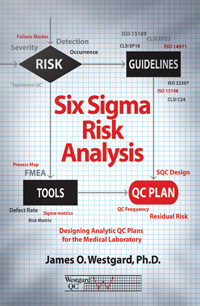
Six Sigma Risk Analysis
First Edition
2011, 296 pages, 6" x 9" perfect bound
ISBN 1-886958-27-0
ISBN-13 978-1-886958-27-2
Risk Analysis is coming to medical laboratories. But for too many labs, Risk Analysis is a buzzword without meaning, an approach without defined technique. At worst, it threatens to appear like science while being implemented like guesswork.
In this book, Dr. Westgard surveys the ISO standards, as well as published CLSI guidelines, and the long-established Joint Commission methodology for Proactive Risk Reduction.
After providing an overview of the general Risk Analysis approach, Dr. Westgard explains how to adapt the principles for the medical laboratory, with performance-based tools and practical implementation tips:
- Process maps, flowcharts and fishbone diagrams
- Risk Acceptability matrices
- Assessment of hazards through Failure Mode Effects Analysis (FMEA)
- Fault Tree Analysis (FTA) and Failure Reporting, Analysis and Corrective Actions System (FRACAS)
- Six Sigma metric integration into Risk Analysis
Using Six Sigma metrics, Dr. Westgard shows how Risk Analysis can be converted from qualitative and ephemeral to something more quantitative and concrete. When performance data informs Risk Analysis, the decisions become more relevant to medical laboratories and the patients they serve.
Don't settle for arbitrary guesswork in your Risk Analysis. Combine the power of Six Sigma and Risk Analysis tools.
Table of Contents
Download the Table of Contents, Preface, and Chapter Excerpts (web membership required)
| CHAPTER | PAGE |
| 1. Controlling Quality |
1 |
| 2. Managing Analytical Quality |
13 |
| 3. Analyzing and Assessing Risk |
25 |
| 4. A Safety Net to Catch Analytical Errors |
51 |
| 5. ISO 14971 Risk Managment for Medical Devices |
67 |
| 6. ISO 15198 and CLSI C24 Guidance for Safe Use and QC |
95 |
| 7. EP18 and EP23 Guidance for Risk Analysis and QC Plans |
113 |
| 8. ISO 22367 Guidance for Risk Management |
137 |
| 9. Adopting the JC Risk Analysis Methodolgoy |
147 |
| 10. Diagramming a Laboratory Process |
163 |
| 11. Identifying Failure Modes |
177 |
| 12. Prioritizing Failure Modes |
189 |
| 13. Determining Root Causes |
203 |
| 14. Mitigating Risks with an Analytical QC Plan |
213 |
| 15. Estimating Detection and Evaluating Residual Risks |
233 |
| 16. Monitoring Failures and Measuring Perofrmance |
259 |
| 17. Implementing Analytical QC Plans |
275 |
| 18. Integrating Six Sigma into Risk Analysis |
283 |
| Index | 291 |